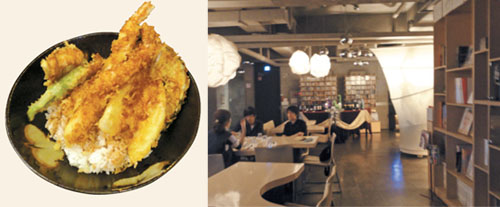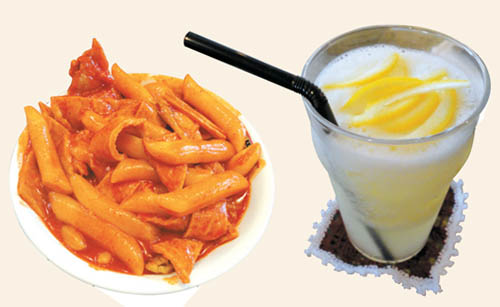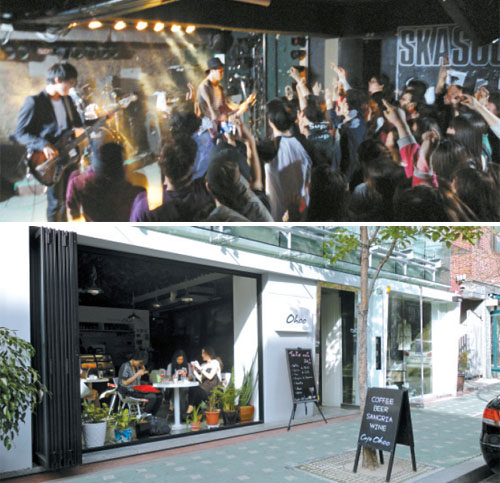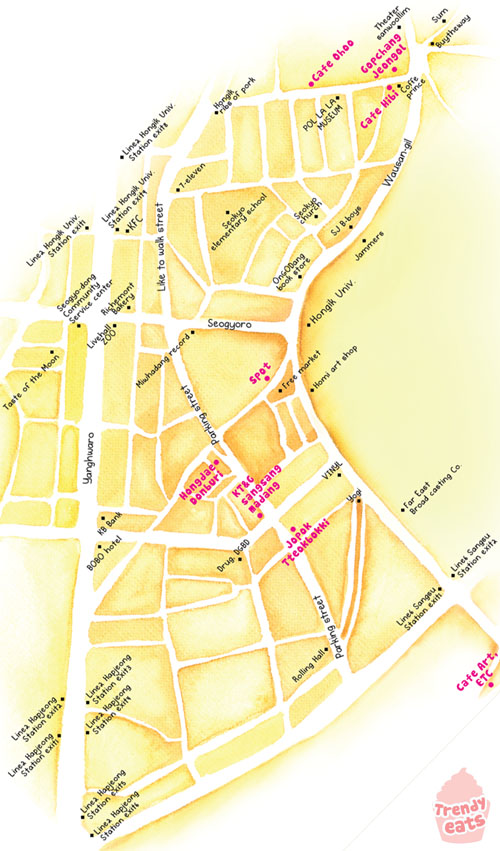Indie spirit lives on in Hongdae’s cafes and clubs

Hongdae Donburi / Sangsang Madang Cafe
There is no shortage of places catering to chic trendsetters looking for luxury and glamour, but young, adventurous types seeking a raw slice of urban life still head out to the area near Hongik University in western Seoul. Despite a recent explosion of upmarket shops, the neighborhood’s indie spirit lives on in live music venues, underground clubs and chill cafes built on a foundation of artistic souls who have migrated here since the 1990s.
One die-hard fan of the area, known as Hongdae, is Kim Bo-reum, a 20-something who regularly spends her free time here shopping at the famous weekend flea market or having a drink with friends at an outdoor bar while watching a performance out on the street.
“Southern Seoul is high-end and ritzy and that’s nice, but Hongdae is the only place in Seoul to see outlandish fashion and wild expressions of individualism,” said Kim.
Located in Mapo District in western Seoul, and stretching from Seogyo-dong to Dongyo-dong, the area around Hongik University, which is famous for its prestigious art department, has long had a reputation as the mecca of underground club culture.
“It was the presence of Hongdae’s art students that first gave the area its artsy feel,” said Lee Geun-young a realtor at Woori Real Estate Agency near Hongik University.
According to Kim Master, an indie musician who has performed in area clubs since 2002, the quirky bars and quaint coffeehouses that now line the streets all have a singular artistic quality because of the independent artists who began calling the area home in the early 1990s.
“Thanks to the cheap rent back then, even artists from Daehangno started moving into the unique ateliers of Hongdae, which they’d later transform into intimate cafes or live music venues,” said Kim.
Today, the area boasts more than 40 underground clubs and cultural venues with shows by over 500 new indie bands a year and enjoys a reputation as the city’s prime spot for Korea’s first generation of indie musicians.
Another Hongdae-area regular is Lee Mee-so, a 23-year-old university student and an ardent art fan who can be found in Hongdae on most days of the week.
One of Lee’s favorite places is Cafe Art, ETC, a small gallery-cum-coffeehouse that exhibits works by up-and-coming local artists.
Owned by illustrator Kim Nam, who has been an active artist since 1998, the cafe aims to be a small, alternative space for local artists to showcase their works. Another similar establishment in the area, Cafe Hibi, is owned by photographer Park Kyung-ho. The cafe, whose name is Japanese for “day by day,” exhibits works by fledgling photographers.
“As an amateur photographer myself, I wanted to provide a place for young photographers to display their works where visitors could hang out,” said Park, who studied photography in Japan for three years.
He said that the time he spent in Japan inspired him to open the cafe, which is covered with magazines and trinkets he brought from that country.
Adjacent to Cafe Hibi is the underground bar Gopchang Jeongol, a throwback to the neighborhood’s old-school rock and roll charm.
Founded 10 years ago, Gopchang Jeongol is modeled after a vintage Korean dabang, or coffeehouse, and is decorated with Jung’s record collection, which numbers in the thousands. A D.J. at the bar plays Korean music from the ’70s and ’80s according to customer request.
Jung Won-young, the owner, opened the bar to give older customers a chance to reminisce about the past while also introducing younger ones to old school Korean music.
“Unexpectedly, more European expats come here nowadays,” said Jung. “They love Korean folk rock and the vintage feel.”
For light-pocketed 20-somethings looking for wine, the cafe located in Sangsang Madang, an 11-story complex with a gallery, gift shop, music venue and movie theater, is a good option. The sixth-floor cafe becomes a wine bar every week on Mondays and Tuesdays.
Hongdae’s other landmarks include its collection of underground clubs and live music venues, including Spot, which gave rise to indie rock bands like Crying Nut, No Brain.
At Spot, a small club with space for up to 40 people, music fans queue up every weekend to watch rookie indie bands strut their stuff.
Adding to the vibrant atmosphere are the area’s late-night eateries, where on most nights, you are likely to bump into a group of musicians who have just finished a set. These shops are sometimes so busy that patrons stand in long queues for the scrumptious dishes on offer.
The iconic Jopok Tteokbokki used to be a cart at a prime intersection but got so busy it had to move to its current location in a shop across the way. And at Hongdae Donburi which specializes in donburi, a Japanese rice-bowl dish, the wait is up to 30 minutes most weekends.
“Hongdae has become the epitome of youth subculture where diverse forms of art are appreciated by young people who have formed their own independent community here,” said Choi Ha-na, who works at Sangsang Madang. “Although it has become more commercial in recent years, I believe that youth culture will continue here because of the deep rooted history of the many young artists the area has produced.”
Hongdae Donburi
This basement restaurant with space for 20 is easy to spot because of the long line outside. With hundreds of customers a day, people often wait for more than 30 minutes to eat. The best seller is the katsudon bento, which is 9,500 won ($8.70).
Lunch is from 11:30 a.m. to 2:30 p.m. and dinner is 5 to 9:30 p.m.
366-18 Seogyo-dong, Mapo-gu, (02) 3141-8398
Sangsang Madang Cafe
This cafe on the sixth floor of Sangsang Madang, a cultural complex, is famous for its wine bar that opens on Mondays and Tuesdays. The wine bar is 10,000 won per person. Side dishes are 9,800 won to 15,000 won.
Hours are 12 p.m. to 12 a.m. Sundays to Thursdays and 12 p.m. to 1 a.m. Fridays and Saturdays.
367-5 Seogyo-dong, Mapo-gu
(02) 330-6232, www.sangsangmadang.com

Jopok Tteokbokki / Cafe Art, ETC
Jopok Tteokbokki
Classic snacks such as tteokbokki (spicy rice cakes), sundae (pig intestines) and tempura keep this renowned shop busy from the moment it opens. The line to order is often so long that customers are told to get a table first. Yoon Tae-myung, named best tteokbokki chef by SBS, opened the shop in 1966. Prices range from 2,000 won to 5,000 won.
Hours are 11 a.m. to 6 a.m.
407-21 Seogyo-dong, Mapo-gu
(02) 337-9933
Cafe Art, ETC
Owned by artist and poet Kim Nam, this cafe and gallery is a gathering place for artists, where conversations about art flow as freely as the coffee. The most popular item is the fresh lemonade and focaccia chicken breast sandwich.
Drinks range from 4,000 won to 9,000 won. Sandwich sets range from 13,000 won to 15,000 won.
Hours are 11 a.m. to 1 a.m. Tuesdays to Sundays.
121-180 Dangin-Dong, Mapo-gu
(02) 3142-1429, www.artetc.org

Spot / Cafe Ohoo
Spot
This club has been promoting bands since 2005. Second Saturdays each month are popular because from 11:30 p.m. to 12:30 a.m. drinks are unlimited for 15,000 won. Concert tickets range from 12,000 won to 30,000 won. Hours vary, but are usually 7:30 to 10 p.m. Tuesdays to Sundays.
358-34 Seogyo-dong, Mapo-gu
(02) 322-5956 or 010-8955-7957 for English (Yang Jung-ah)
http://cafe.daum.net/clubspot
Cafe Ohoo
With a large feather painting and photos on the walls, Ohoo feels like an art gallery, and artists display their works upon request. The affogato is the most popular dessert but side dishes like salmon salad and honey cinnamon toast are also available. Drinks start at 4,000 won and side dishes range from 4,000 won to 15,000 won.
Hours are 12 p.m. to 1 a.m. Sundays to Thursdays and 12 p.m. to 2 a.m. Fridays and Saturdays.
121-836 Seogyo-dong, Mapo-gu
(02) 335-7730, http://cafe.naver.com/cafeohoo

Gopchang Jeongol / Cafe Hibi
Gopchang Jeongol
This bar plays vintage records and offers Korean drinks such as makgeolli, or unrefined rice wine, and side dishes. Drinks start at 4,000 won and side dishes are 13,000 won to 15,000 won.
Hours are 7 p.m. to 4 a.m. on weekdays and 7 p.m. to 5 a.m. on Saturdays.
327-17, Seogyo-dong, Mapo-gu
(02) 3143-2284
Cafe Hibi
This Japanese cafe and gallery is owned by chef Park Kyung-ho, who brought his secret curry recipe to Korea from Japan. Drinks start from 4,000 won and meal sets range from 12,000 won to 15,000 won. Hours are 11 a.m. to 11 p.m. Sundays to Thursdays and 11 a.m. to 12 a.m. Fridays and Saturdays. It’s closed every first Tuesday of the month.
337-1 Seogyo-dong, Mapo-gu
(02) 337-1029
http://blog.naver.com/cafehibi

By Special Reporting Team [estyle@joongang.co.kr]










with the Korea JoongAng Daily
To write comments, please log in to one of the accounts.
Standards Board Policy (0/250자)